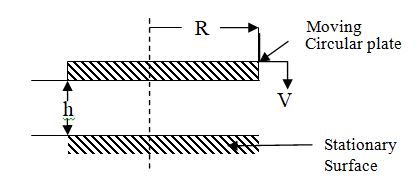Statement for Linked Answer Q1& Q2
The gap between a moving circular plate and a stationary surface is being continuously reduced, as the circular plate comes down at a uniform speed V towards the stationary bottom surface, as shown in the figure. in the process, the fluid contained between the two plates flows out radially. The fluid is assumed to be incompressible and inviscid.

- The radial velocity Vr, at any radius r, when the gap width is h, is
(a) $V_{r}=\frac{Vr}{2h}$ (b)$V_{r}=\frac{Vr}{h}$
(b)$V_{r}=\frac{Vr}{h}$ 
(c)$V_{r}=\frac{2Vh}{r}$  (d) $V_{r}=\frac{Vh}{r}$
(d) $V_{r}=\frac{Vh}{r}$ 
2 . The radial component of the fluid acceleration at r = R is
(a) $\frac{3V^{2}R}{4h^{2}}$  (b)$\frac{V^{2}R}{4h^{2}}$
(b)$\frac{V^{2}R}{4h^{2}}$ 
(c) $\frac{V^{2}R}{2h^{2}}$  (d) $\frac{V^{2}R}{2r^{2}}$
(d) $\frac{V^{2}R}{2r^{2}}$